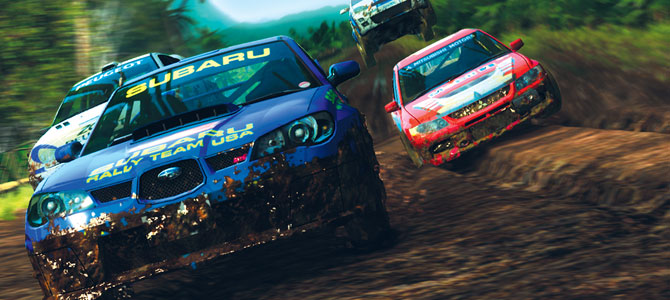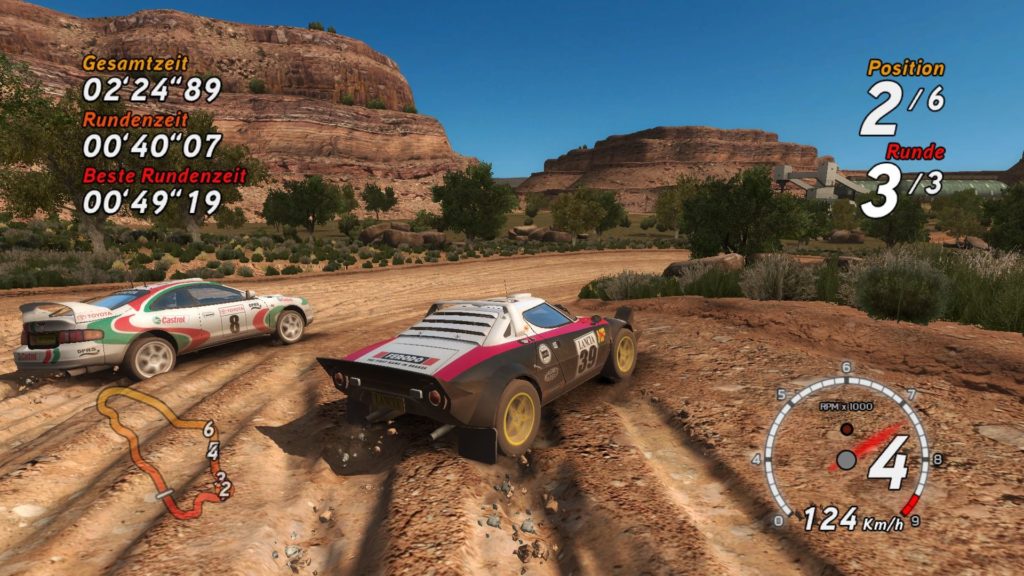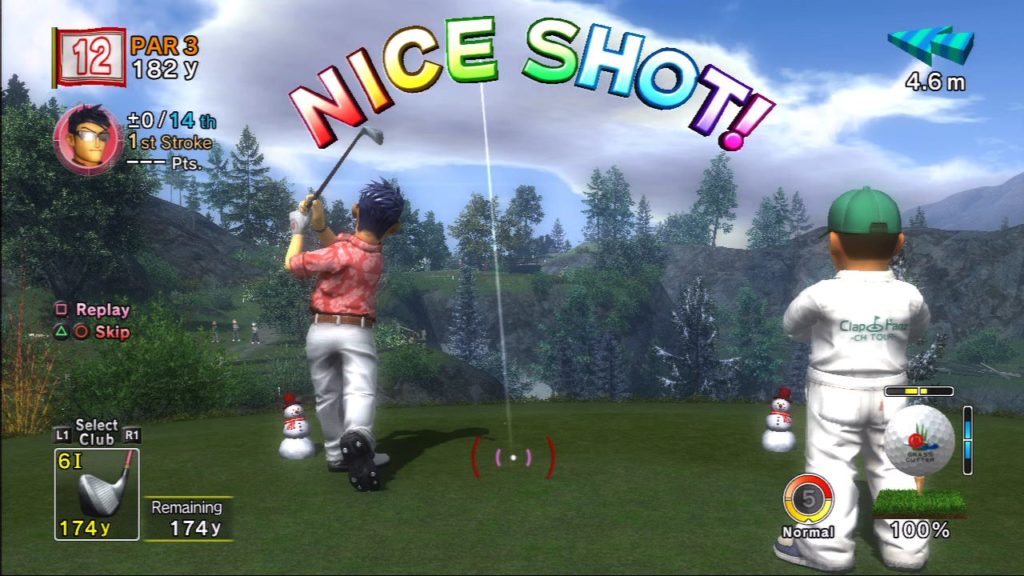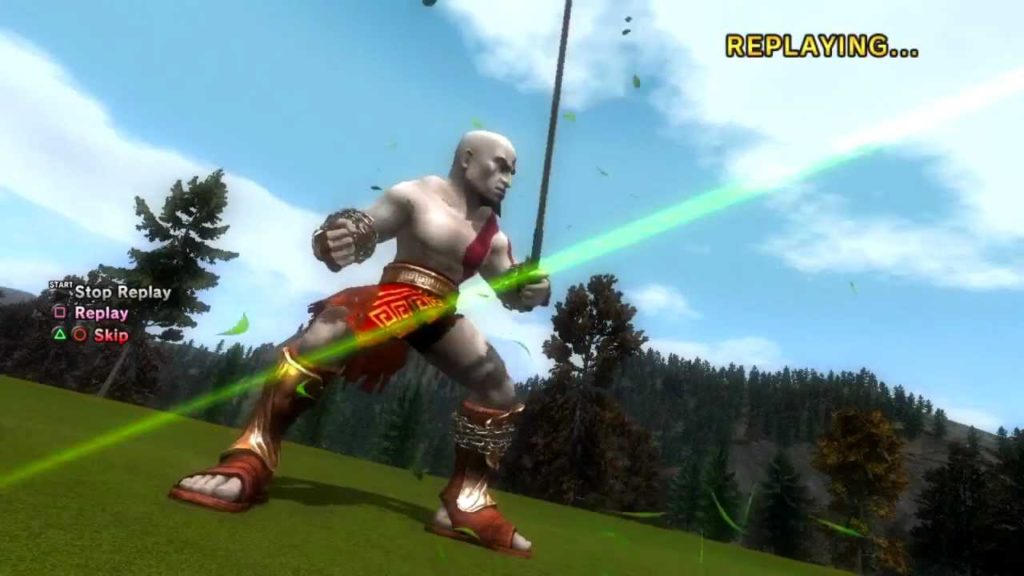
Sega Rally Revo – Sega’s failed reboot of Sega Rally circa 2007 (also called Sega Rally, with no subtitle, in Europe – confusing!) is actually a pretty great game!
Sega Rally demands a very strange skill of the player – the ability to follow directions (EASY LEFT, EASY RIGHT) while also knowing how to traverse corners. And, I wager cornering skills constitute the bulk of the game’s challenge. Due to the primary feature of rally racing – real, variable terrain – the handling of your car demands a certain finesse when entering, running through, and exiting a corner with the maximum speed possible without crashing into someone or something. Tilting the analog stick left and right in Sega Rally Revo doesn’t so much turn the car as it does make it swerve sideways! Swerve too much, and you’ll end up turning too far into the turn and lose all speed; swerve too little, too late, and you’ll slam into a wall.

As such, cornering in Sega Rally Revo requires a very precise, measured understanding how and when to turn into a corner, obviously. But the real thrill is figuring out whether or not you made the right decisions, since adjusting your trajectory in the middle of the turn could prove dangerous. If you start messing with the trajectory of your car in the middle, things don’t usually end well since you can’t really determine where the car’s going to go. Have you heard about the real life phenomenon of hydroplaning? That’s exactly what a bad turn feels like in Sega Rally Revo, and boy does it not feel good when you slam into a wall due to poor decisions! On the other hand, a good turn feels like you’re drifting over a sheet of glass, smoothly sliding over it until you somehow manage to wrest control right back from the brink at the end of the turn. Simply put: it’s pretty great! Each turn is a test and a reward all the same, and the variable terrain that shifts as the race progresses adds that extra bit of randomness that forces minute adjustments – predictable one, but challenges all the same.
I can see why this wasn’t successful back in 2007, though – not only does it stay completely true to the arcade racers of old, with no customization or car damage to speak of, the game’s AI seems designed to take your tokens away with alarming frequency. Whether or not they’ve particularly smart is beside the point, as the other racers can, and will, punish you for mistakes. Adding insult to injury, there’s no retry button in the middle of a circuit, so you better race like your life depended on it. That kind of design didn’t fly too well back then, and probably doesn’t now!
Thankfully, we live in the year 2016, where Sega Rally Revo copies go for a grand total of about 2-5 dollars USD – if you have a PS3 or an Xbox 360, I’d suggest giving it a go before all the copies dry up or are destroyed from frustration. Sega arcade racers always use licensed cars, and considering how poorly this sold, I wouldn’t expect a re-release any time soon (they even pulled it from Steam!).

Hot Shots Golf: Out of Bounds – I can’t imagine why I haven’t played any iteration of the Hot Shots Golf series. Maybe it’s because Mario Golf always appeared as a better, branded alternative to the kind of simplistic golfing fun that Hot Shots Golf also purveys? Regardless, both series come from the pedigree of the same developer, Camelot, who developed the original Hot Shots Golf; far as I know, Nintendo bought a controlling stake in the company, and now they only make Nintendo games exclusively. This means Hot Shots Golf (or Everybody’s Golf if you’re Japanese) took a very different route towards the same avenue of accessible video game golf.
And that route seems utterly foreign to me in some ways. Hot Shots Golf: Out of Bounds (the first PS3 entry in the series) uses all the traditional tropes of this genre, from the three click swing meter to adjustment for wind, topspin/backspin, and so on. There’s only a few big differences to note, like not knowing what the wind speed is when you go for the first stroke of any course (accurate to real life, weirdly enough) and a lack of adjusting spin before a shot (you have to do it during the shot instead). Also, the meter for the swing is yellow with a white marker moving back and forth, which hurts my eyes just to look at; I’d call that a bad color palette choice, to say the least!

Probably the biggest shift comes from the absolute need for accuracy. In Mario Golf games, failing to hit the third button press usually meant your ball went a little bit off course – nothing too extreme. Since you could clearly see the number of bars your press sits away from a perfectly straight shot, it made sense. Hot Shots Golf uses a far more fluid and nuanced system by comparison, since you can’t tell a perfect shot unless it’s truly perfectly timed. If it isn’t, be prepared for the ball to fade, slice, and fly around in all sorts of random directions! Sometimes, it doesn’t even make sense how being slightly off with a shot makes you careen into a water hazard, or that this minute off hit could possibly lead to a bunker. True to actual golf? Probably. Good for a kid-themed golf game for the whole family? I’m not sure, quite honestly.
None of this makes Hot Shots Golf bad by any measure – simply different. If you’re up for a golf game like this, I can’t see going wrong with it!
